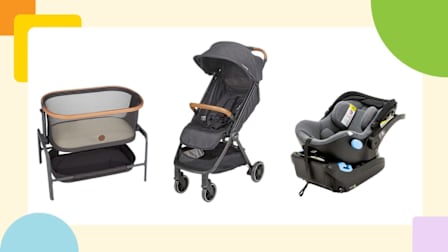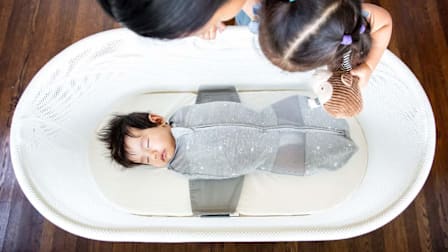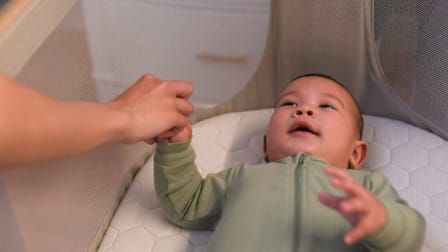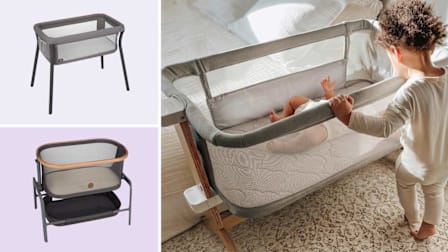Should You Buy a Snoo Smart Bassinet for Your Newborn?
Here’s what experts want you to know about the popular baby bed
When you shop through retailer links on our site, we may earn affiliate commissions. 100% of the fees we collect are used to support our nonprofit mission. Learn more.
“You have to write about the Snoo,” my friend said. We were at dinner, and she had recently told me she was pregnant with her first baby.
“The what?” I said.
“The Snoo,” she said. “It’s a ‘smart’ bassinet. The parents I’ve talked to literally will not shut up about this thing. As soon as I tell anyone I’m pregnant, it’s one of the first things they ask me: ‘Are you getting a Snoo?’ ”
- What Is the Snoo? Does It Work?
- Concerns About the Snoo: White Noise The Swaddle Digital Privacy
- Weaning Your Baby Off the Snoo
- The Bottom Line
What Is the Snoo?
It’s a popular, $1,695 smart baby bassinet (available at Happiest Baby, Amazon, and Target) that gently rocks and plays white noise to calm fussy newborns—and, theoretically, gives parents more sleep time. It can also be rented for $159 per month plus fees, return shipping, and a $99 refundable security deposit.
Beginning July 15, 2024, a Snoo purchased from Happiest Baby or an authorized retailer comes with nine months to its premium app subscription. If bought elsewhere (such as on Facebook Marketplace), Snoo owners need to pay $19.99 a month for access to the premium subscription after the July date, though they’ll have access to the free version of the app. (See full details about the app subscription.)
It was created by a pediatrician, Harvey Karp, MD, alongside Deb Roy, a professor of media arts and sciences at the Massachusetts Institute of Technology, and a Swiss designer, Yves Béhar. Karp launched it as the hallmark product of his company, Happiest Baby, in 2016.
The Snoo incorporates elements from Karp’s bestselling book, “The Happiest Baby on the Block,” in which he details his “5 S’s,” which he claims are the secret to calming a fussy baby. These are swaddle; side or stomach position; shush; swing; and suck.
The Snoo uses swaddle, swing (though it’s not an actual baby swing; really, it rotates back and forth in a rocking motion more than it swings), and shush to help the baby chill out and sleep through the night.
Karp says the Snoo is more of a 24-hour “robotic caregiver” than a mere baby bed. Its internal microphones pick up when the baby begins to cry, and it responds with vibration and white noise. If the baby continues to cry, the Snoo increases the intensity of its movement and white noise.
Since its introduction, the Snoo has catapulted to the Baby Hall of Fame. It has won multiple awards for its design and technology and is beloved by legions of parents. Product reviews, online blogs, and countless other online testimonials attest to how many parents report success with the Snoo’s ability to calm their baby.
In March 2023, the Food and Drug Administration granted the Snoo “De Novo” approval, which classifies a novel product as a medical device for a particular use. In this case, the Snoo has been approved as a Class II medical device that has been evaluated to safely keep the baby secure on its back. Infants who sleep that way are less likely to die of sudden infant death syndrome (SIDS) than those who sleep on their side or stomach.
But the Snoo hasn’t been approved as a product that prevents SIDS. According to the FDA, there are no infant sleep systems or positioners that are allowed to be marketed as preventing or reducing the chances of SIDS or sudden unexpected infant death (SUID). The FDA has verified, though, that the Snoo doesn’t increase the likelihood of SIDS/SUID.
How the Snoo Works
Babies wake up in the middle of the night for a wide variety of reasons. Oftentimes, they need attention, perhaps because they’re hungry or need a diaper change. But sometimes babies wake up because they feel or hear something—a draft from an open door, a dog barking, a phone ringing—and can’t fall back to sleep. Typically, if a baby starts crying in these situations, a parent will pick them up, take care of whatever needs the baby has (such as feeding), and then sing and rock them to sleep.
The Snoo is designed to step in with the shushing, rocking, and swaddling that would otherwise keep parents awake as they try to coax their baby back to sleep. When the baby begins to wiggle and cry, the bed responds by rocking back and forth, escalating the rocking and white noise if the baby’s fussing doesn’t ease.
The bed has five rocking settings, ranging from the level of movement a baby feels in a caregiver’s arms to the jostling one feels in a car on a bumpy road. The white noise levels follow a similar trajectory. The bottom “blue” setting is designed to be left on all night, gently shushing and rocking the baby in an attempt to keep them asleep as long as possible. And if the baby doesn’t stop crying after a couple of minutes of the bed’s increasing rocking and white noise, it turns off. The user guide says that if the Snoo has timed out, parents should attend to their baby.
Parents can elect to use the Snoo app to track their baby’s sleep habits, including wake-ups and sleep duration. They can also use the app to get alerts about the baby’s movement and remotely control the bassinet. But the app isn’t required to use the Snoo, and more privacy-oriented parents can choose to control the bed using the button on its front rather than relying on a WiFi-controlled phone app.
To keep the baby securely in place during the bed’s rocking motions, the Snoo comes with a proprietary swaddle called the Snoo Sleep Sack that clips into the sides of the bed. Additional sleep sacks are $35 apiece.
A baby doll in the Snoo.
Does the Snoo Help Babies Sleep?
Alisa Richter, a New York parent of two young children, rented the Snoo. She says the first couple of days home from the hospital were “hellish” because her baby had a lot of trouble sleeping, so she ordered one on a whim. “I loved it. It soothed him to sleep and alleviated a lot of my own postpartum anxiety,” she says. “It’s not essential, but I like the extra comfort it provides.” Her second child, a newborn, also sleeps well in the Snoo, she says.
There has been only one independently published peer-reviewed full study of the Snoo that Consumer Reports was able to find. The small 2019 study, published in the scientific journal PLOS One, looked at how the Snoo calmed 69 infants compared with how well they were calmed when they were swaddled in their parents’ arms, rocked, and shushed. “We found that babies responded with a calming response to swaddling, movement, and sound when soothed with the Happiest Baby method and with the Snoo—less observed fussiness and lower heart rate” when compared to sitting with the baby or laying the baby on his or her back, says Eline Möller, now a senior researcher at Amsterdam University Medical Center. (She conducted the 2019 study through the University of Amsterdam.) There haven’t been any follow-up studies, but a team of Dutch psychologists published a response to the paper, arguing that the “mechanical soothing” provided by the Snoo was “insensitive by definition.”
John Belanger of California and his wife loved the Snoo for their infant. “Our baby slept well in the Snoo, which helped us—mom and dad—sleep, too, because it did such a great job,” he says. “It gave us peace of mind knowing that our baby was safely and comfortably swaddled.” He adds, however, that he can’t be 100 percent sure his baby’s thorough nighttime sleep was because of the Snoo. “Perhaps our baby is just a good sleeper; can’t say for sure. Whether it was our baby or the Snoo, all of us—baby and parents—got good sleep.”
Be Cautious With the Snoo’s Built-in White Noise
One of the hallmark features of the Snoo is its built-in white noise machine. It can’t be turned off when the Snoo is on, meaning that unless parents want to use the Snoo completely off (as if it were a regular bassinet), they and their baby are locked into some level of white noise. According to Karp, the Snoo’s baseline white noise level is between 65 and 70 decibels at the baby’s ear—about the sound of a normal conversation or an office space. (The Happiest Baby website lists the sound level between 68 and 70 decibels.) Its highest level, which plays when the baby is very upset and crying loudly, is around 85 decibels, which is as loud as city traffic.
Not only does the Snoo require the use of white noise, Karp also recommends continued use of white noise for up to two years after the baby has outgrown the bassinet. Happiest Baby sells the Snoobear ($60), a responsive plush “lovey” that plays white noise for babies and toddlers for 30 minutes to an hour at a time.
Limited research has found that white noise can be calming for babies. A 2018 randomized controlled trial looked at how 40 1-month-old babies with gas pains responded to white noise played at 55 decibels. It found that those who listened to white noise slept significantly more and cried significantly less than babies who were swung.
But medical experts don’t know exactly how much white noise, and at what volume, is safe for babies’ delicate ears. The existing research is sparse; most of the research on harmful noise has been conducted with adults. According to the World Health Organization, hospitals shouldn’t exceed 40 decibels at night and 30 decibels during the day. Long-term exposure to noise exceeding 65 decibels for adults has been correlated with heart disease. And according to the Centers for Disease Control and Prevention, noise exposure of 80 to 85 decibels for adults for over 2 hours can damage hearing.
Pediatric audiologists urge caution when using white noise machines with babies. In 2023 the American Academy of Pediatrics released new guidance regarding pediatric noise exposure. The AAP recommends that caregivers place the white noise machine as far away from a baby’s head as possible, use the lowest possible volume, and use the device only for a short time.
A 2014 study published in the AAP’s official journal, Pediatrics, looked at 14 white noise machines made for infants and relied on a 50-decibel noise limit suggested by two small scientific reviews of the few studies related to infants and noise, one published in 1999, the other in 2000. It found that all 14 devices exceeded the 50-decibel limit for babies in nurseries when placed about a foot (30 centimeters) away from the baby, concluding that if parents use white noise machines, they should always be placed at the lowest possible level and at least 7 feet away from the baby’s bed—never in a crib or on a crib rail.
The Snoo’s white noise machine is in the crib, right beneath where a parent may lay their baby’s head. (Babies can be placed in the opposite direction in the Snoo if parents want their baby’s head to be farther away from the speaker.) And its noise, even at its lowest level of 65 to 70 decibels, exceeds the limits recommended by the study and by audiology experts. “Fifty dBA averaged over an hour would be a safe limit and should not induce any degree of hearing loss,” says Chantal Laroche, PhD, a professor emeritus of audiology and speech language pathology at the University of Ottawa in Ontario. “Not knowing well the effects of noise on the hearing of young babies, it is better to be more careful than not enough.”
Karp says that white noise, on any level, isn’t supposed to be played 24/7 because babies need at least several hours a day to listen to normal, day-to-day sounds of their parents’ voices and the general noise of a home. If using the Snoo, parents can do this either by turning it completely off or letting their baby hang out outside the Snoo.
To be safe and protect their baby’s ears, parents electing to use white noise machines should play it at its lowest level for a limited time, according to the AAP.
Experts Express Concerns About the Swaddle
According to the user guide, babies should be strapped into the sack whenever they are in the Snoo. “If you’re swaddling babies, and you’re rocking them, you better secure them in place so that they can’t go to an unsafe position,” Karp says. “And that’s one of the key benefits of Snoo.” The Snoo sack prevents a baby from shifting onto their side or stomach and risking suffocation when they’re in the Snoo while it is moving. To a certain extent, this is in keeping with safe infant sleeping practices, which dictate that a newborn should be placed to sleep on their back. Placing a young baby to sleep on their stomach or side is a leading risk factor for SUID, or sudden unexpected infant death. The Snoo is designed to be used for up to six months, after which a baby is supposed to be transitioned into a crib.
But some experts say that swaddling a baby, which is effectively what the Snoo Sleep Sack does, isn’t appropriate after 3 to 4 months because it can be unsafe and have negative developmental and health effects once the infant is a little older.
“It’s recommended in the empirical literature and by pediatricians that as soon as the baby is able to roll, which generally happens around 3 to 4 months, they should abandon the swaddle altogether,” says Wendy Hall, PhD, a professor emeritus in the School of Nursing at the University of British Columbia, whose research focuses on infant sleep. “The American Academy of Pediatrics recommends putting an infant on their back to sleep, but if the infant independently repositions him or herself by rolling onto their tummy, it’s safe and desirable to allow that.”
Swaddling in a sack that’s secured into the Snoo is a practice that, while not directly addressed in American Academy of Pediatrics guidelines, would contradict recommendations on allowing a child to roll over when they’re able to on their own. “Strapping a baby to a mattress via swaddle, or any device, is not consistent with AAP recommendations,” says Lori Feldman-Winter, MD, a professor of pediatrics at Cooper Medical School of Rowan University in Camden, N.J., and a member of the AAP Task Force on SIDS (sudden infant death syndrome).
Because active use of the Snoo (with the motion and white noise on) requires that a baby is strapped into the Snoo sack, if parents follow AAP recommendations, they’re getting as little as three months of Snoo use before the baby should be transitioned to another crib.
When I asked Karp about the concerns raised by experts we talked to about keeping babies swaddled longer, he disagreed that it was an issue. “That’s a misunderstanding on their part, because the reason we stop swaddling at 2 to 3 months is because we don’t want babies rolling over swaddled,” he says. “Because that raises the risk of infant sleep death. But if the baby is secured as they are in [the] Snoo, there’s no risk of rolling over.”
But the risk from rolling over wasn’t the primary concern raised by many of the experts interviewed. We primarily heard about developmental concerns. (The product falls under the government’s bassinet standard and conforms to those mandatory safety rules.) According to Violet Giannone, a nurse, pediatric sleep consultant, and author of the book “Baby Sleep Training in 7 Days,” babies also need to be able to move around a bit. “When a baby is forced to remain on their back—which is essentially what the Snoo is doing—this can cause some developmental delays,” she says. Babies practice their milestones in their cribs or bassinets, in large part because they spend so much time there, she says. “With the Snoo, the baby is not able to practice one of the very first few milestones—rolling. Even if they happen to practice it outside of the crib, they are not getting enough practice time, which can cause a domino effect in delays in milestones.”
Rosemary Horne, a professor of pediatrics at Monash University in Melbourne, Australia, whose research focuses on pediatric sleep problems, including SIDS, says swaddling for too long can negatively affect a baby’s physical development. “Swaddling is often used to suppress startle reflexes in young babies, but the continued use of such a restrictive swaddle may impair normal development of the babies’ movements of their arms and hands,” she says. Happiest Baby has guidelines on how parents can remove their baby’s arms from the Snoo sack at 4 to 5 months, if desired, though Horne says “it is recommended that the arms of babies are left unswaddled from 3 to 4 months of age.”
Susan Klemm, an occupational therapist whose work focuses on infants’ head shape and developmental issues, and her colleague Stacy Conder, a physical therapist, own an infant and childhood physical and occupational therapy practice in Charlotte, N.C. They say they’ve frequently discussed head shape and developmental delays with the Snoo with pediatricians and other pediatric therapists, who share similar concerns.
They’ve written about how the Snoo can exacerbate head shape issues in infants already prone to them, and agree with Giannone and Hall, both of whom say that the Snoo can in some cases lead to developmental and physical delays in newborns. “When repositioning during sleep is impeded, rolling when awake can be delayed, which can lead to delayed crawling and, perhaps most important, exploration of the environment,” Klemm and Conder say. “Unfortunately, we frequently see infants whose development and/or head shape are negatively affected by restrictive sleep positioners, including the Snoo.”
Such head shape issues include plagiocephaly, also known as flat head, in which a newborn’s head is slightly flat and asymmetrical on one side. Though it’s sometimes congenital, most cases fall into the category of “positional plagiocephaly,” which can be caused by putting a baby in the same position—such as on their back—day after day during the first 12 weeks of life. This doesn’t occur only in the Snoo, and the issue is relatively common, Giannone says. Plagiocephaly has become more common since the anti-SIDS Back to Sleep campaign launched in 1992, according to the AAP. And though the condition is straightforward to treat, in rare cases, untreated plagiocephaly can lead to chewing problems, vision issues, and facial abnormalities, according to the American Association of Neurological Surgeons.
Babies who get “tummy time” and sleep 14 hours or so in the Snoo, with the remainder spent elsewhere (such as in their parents’ arms or in a baby carrier) are less likely to experience developmental delays and a flat head than babies who spend 18 daily hours of sleep in the same position without that crucial tummy time, Giannone says. But because babies often roll for the first time at night when they’re alone in their own space, parents may miss that important milestone and keep babies in the Snoo longer than they should, she says. They might miss these early signs if a baby is in day care, too.
Consumer Reports advises parents and caregivers that they can let their baby sleep for short stretches in an infant carrier or car seat if they’re used properly and the baby is positioned as directed by the manufacturer’s instructions. Just don’t over-rely on them, says William Wallace, CR’s associate director of safety policy. “Infant carriers and car seats are meant for transit, and should not be used as a substitute for a safe sleep environment,” he says. “CR recommends that parents and caregivers move their baby to a crib, bassinet, or play yard if the baby is still sleeping once they arrive at their destination.”
Karp says there’s no more risk of developmental delays like flat head from the Snoo than from any other baby bed. “Babies in Snoo have the full range of motion of the neck—to turn the head fully to the right or left. This is exactly the same as for babies who sleep in any other baby bed,” he says. “Babies aren’t exercising during sleep—they are sleeping.”
The AAP recommends that babies who can roll over on their own be removed from their swaddle and given the freedom to move. Parents who use the Snoo can help give children the freedom to develop at their own pace by moving them to a new bassinet as soon as they show signs of rolling. Some parents may choose to use the weaning feature for a couple of weeks before transitioning their child out of the Snoo. To ensure that parents don’t miss those early milestones, they can give their baby lots of time outside the Snoo in a safe area, under careful supervision, where they can wiggle, roll, and explore.
Digital Privacy and the Snoo
In 2019 the cybersecurity firm Red Balloon found a concerning digital vulnerability in the Snoo. An attacker on the same WiFi network as the Snoo could theoretically access and control the Snoo remotely. The researchers were able to violently rock the Snoo and play loud noise, up to 113 decibels. Red Balloon alerted Happiest Baby of the vulnerabilities and Happiest Baby quickly patched the vulnerability and rolled it out to all units. “This is done automatically, so even older units are patched as soon as the minute they connect to WiFi,” Karp says. No real-life attacks on the Snoo have been reported.
Joe Carrigan, a senior security engineer at Johns Hopkins Institute of Assured Autonomy in Baltimore, says he’s “pretty pleased” with the Snoo’s overall device security, including its ability to operate well without WiFi and its assurance in its data policy that it won’t sell data to marketers. (Data collected by wearables and smart devices like the Snoo aren’t protected by HIPAA.) “It seems to me like this system is probably more secure than most,” he says. But privacy policies can change. This is a concern about all connected devices and online services, not just the Snoo.
Though the risk of hacking is low, those who are concerned about their Snoo being hacked can disconnect it from WiFi. The device retains most of its functionality, but parents won’t be able to control it from their phone app or view their baby’s sleep report. Instead, they can operate the Snoo from the controls on the front of the bassinet. Conversely, having careful data security on the Snoo’s home WiFi system can mitigate any additional risk if parents wish to keep their bassinet connected.
Weaning Your Baby Off the Snoo
Richter moved her baby out of the Snoo at 3 months old. “Transition was actually fine because he clearly wanted more space to move around,” she says. “We always had an additional white noise machine, which is crucial.” He was very happy in his new crib, she says.
But according to Giannone and some parents on various online forums, some babies become dependent upon their Snoo for sleep to the point where it can be difficult to wean them off its rocking and white noise. “I work with so many families that just want their baby to sleep after being transitioned out of the Snoo; they’re having a really hard time sleeping and settling,” Giannone says. “I don’t think parents are aware of what they’re setting themselves up for, with not allowing the baby to learn to sleep independently.” Not every baby has issues transitioning out of the Snoo, she says, but “the majority that I work with have these troubles.” Hall says that six months of early life spent consistently in the Snoo, plus up to two years of exposure to the Snoobear white noise machine, “could lead to a reliance on [white noise] for sleeping.”
This is despite the Snoo’s weaning feature, which is meant to help ease the baby’s transition from the Snoo to a crib. A week or two before a baby is ready to move on from the Snoo, parents can turn on weaning mode, which doesn’t rock at the blue baseline level, though it does play white noise. If a baby cries, though, the Snoo responds with some rocking until the baby stops crying, at which point it stops moving and sticks with the white noise. Happiest Baby recommends that Snoo users continue using the white noise until the baby is up to 2 years old.
What to Expect says babies can become dependent on white noise, which can present issues if, for whatever reason, white noise isn’t available. In such cases, it may be necessary to first wean the baby off the rocking, then the white noise, by gradually lowering the sound on your white noise machine over the course of a couple of weeks until it’s off, according to Karp.
The Bottom Line
Some parents swear by the Snoo, saying it’s led to better sleep for both infants and themselves and other caregivers. And the FDA says it doesn’t increase the risk of SIDS. But if you’re considering splurging on a Snoo, you should know that experts have raised concerns that the constant white noise may damage hearing, the swaddle may inhibit movement and development, and some babies may have trouble transitioning to a regular (nonrocking) bassinet or crib. The bottom line is that, especially given the popularity and potential benefits of the Snoo, much more research is needed on its efficacy and safety so that parents can make more informed decisions about whether it’s the right choice for them.





























